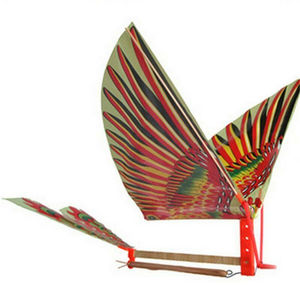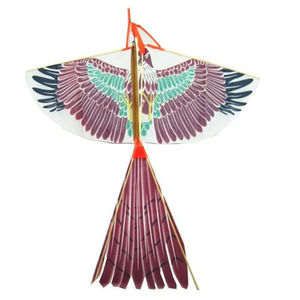
All categories
Featured selections
Trade Assurance
Buyer Central
Help Center
Get the app
Become a supplier

(938 products available)


































The ornithopter birds are a great combination of engineering and nature. These are mechanical devices designed to fly by flapping their wings like birds. Different types of ornithopter birds have been developed in various fields. They can be used for research purposes, surveillance, or entertainment. Each type has unique features and capabilities. These can capture the essence of flying birds.
Mechanical ornithopter birds
Mechanical ornithopter birds fly by flapping their wings through mechanical means. They have a system of motors, gears, and linkages. These allow the wings to flap. This type of ornithopter is often used for research and education. It demonstrates the principles of flight and robotics. Mechanical ornithopters can be built in different sizes. These range from small models that fit in a classroom to large ones used in outdoor demonstrations.
Electric ornithopter birds
The electric ornithopter uses electric motors for wing flapping. They are powered by batteries, making them suitable for short flights. These are mostly used for testing purposes or demonstrations. Electric ornithopters are quieter and cleaner than their gas-powered counterparts. This makes them more suitable for indoor use or areas where noise and pollution are concerns.
Remote-controlled ornithopter birds
These ornithopters are designed to be controlled remotely. They can be either mechanical or electric. Remote-controlled ornithopters are often used in research, surveillance, or entertainment. These can be small enough to be carried around or large enough to be seen from a distance. They can fly in different terrains. The remote control allows users to maneuver them. It can be used to study bird behavior or survey land.
Solar-powered ornithopter birds
Solar-powered ornithopters are another type. They use solar panels to convert sunlight into electricity for propulsion. This type of ornithopter is ideal for long-distance flights. It can fly continuously as long as the sun is shining. Solar-powered ornithopters can be used for environmental monitoring. They can also be used to demonstrate the potential of renewable energy in aviation.
Hybrid ornithopter birds
Hybrid ornithopters combine different power sources and flight mechanisms. They may have both mechanical and electrical systems. These can include the use of gas engines along with electric motors. Hybrid ornithopters benefit from the advantages of each type. They can fly longer distances or carry heavier payloads than their all-electric or all-mechanical counterparts.
Glider ornithopter birds
Glider ornithopters are designed for soaring rather than flapping. They have large wings that take advantage of thermals and updrafts to stay aloft. This type is useful for long-duration flights where energy efficiency is more important than rapid ascent. Glider ornithopters can be used for environmental monitoring or scientific research.
Autonomous ornithopter birds
Autonomous ornithopters are equipped with sensors and computers. These allow them to fly without human control. They can be used for surveillance or reconnaissance missions. They can also be used for search and rescue operations. Autonomous ornithopters can make decisions based on their observations. They can change their flight paths accordingly.
Biomimetic ornithopter birds
Biomimetic ornithopters are designed to imitate specific birds or other animals. They may use the same shapes and colors as their living counterparts. The aim of this type is to blend in with nature for observation or research purposes. These ornithopters can be used to study animal behavior or monitor ecosystems without disturbing them.
The design of ornithopter birds can be classified into different types based on the mechanism of their wings and the purpose they are built for.
Classification by wing mechanism
One can categorize ornithopters by how their wings are made to flap. Some ornithopters have fixed wings. These wings stay the same when flapping happens, like how many real birds do it. Other ornithopters use flexible wings. In this case, the wings change shape as they flap to improve flight efficiency. The flapping mechanism can also be classified further. Some ornithopters use gear-based mechanisms. These gears transfer power from motors to make wings flap. Crank-based mechanisms use cranks to flap the wings. Linkage systems use mechanical linkages to control wing movement.
Classification by size and scale
Ornithopters can be classified according to their size and scale. This classification includes mini ornithopters. They are tiny, measuring only a few inches across. They are usually used for research or surveillance. Then, there are small-scale ornithopters, which are bigger than minis. They can measure up to 5 feet across. Small-scale ornithopters are often used for education and demonstration purposes. Medium-scale ornithopters are bigger than small scales. They can measure up to 15 feet across. They are usually used for entertainment and art shows. Large-scale ornithopters are the biggest. They are usually used for experimental flight testing.
Classification by purpose
One can also classify ornithopters by their purpose. This classification includes military ornithopters. They are designed for reconnaissance missions. They are usually equipped with cameras and other sensors. Research ornithopters are designed for scientific studies. They may have special instruments to collect data during flights. Art and entertainment ornithopters are meant to dazzle audiences. They may have flashy designs and special effects during flight. Education ornithopter birds are built to teach people about flight. They often have transparent parts so that bystanders can see how they work.
Ornithopter birds have many applications in science, military, entertainment, and conservation fields. These applications show how ornithopters can be used in various fields to solve problems and improve technology.
Scientific research
Ornithopters are used for studying bird flight, ecology, and behavior. Scientists can learn about wing movements, energy efficiency, and patterns of flight by studying ornithopters. They can also be used to study hard-to-reach areas or sensitive species without disturbing them.
Environmental monitoring
Ornithopters can monitor ecosystems, collect data, and assess environmental health. They can be deployed in remote or hazardous areas to survey wildlife, track habitat changes, or monitor pollution. Their ability to mimic birds can help them blend into natural environments and reduce their impact.
Military applications
Ornithopters serve as surveillance drones for reconnaissance and intelligence gathering. Their bird-like appearance can help them avoid detection and reduce the risk of being targeted. They are useful for gathering information in urban environments or areas with tight restrictions on airspace.
Entertainment and education
Ornithopters are used in museums, science centers, and educational programs to teach about biology, engineering, and robotics. They can demonstrate how birds fly, inspire students to learn about science and technology, and raise awareness about conservation. In entertainment, ornithopters can be featured in movies, shows, and theme parks to showcase advanced technology.
Conservation efforts
Ornithopters can assist in wildlife conservation and habitat protection. They can be used for anti-poaching patrols, monitoring endangered species, and surveying protected areas. Their ability to fly quietly and navigate complex environments makes them valuable tools for conservationists.
Choosing an ornithopter bird model involves considering several factors that ensure the model meets the user's expectations and purposes.
Purpose and Usage:
Determine the primary purpose for which the ornithopter will be used. Is it for education, research, hobbyist flying, or as a decorative piece? Different ornithopters are designed for specific purposes, so knowing your primary interest will help narrow the choices.
Size and Scale:
Consider the size of the ornithopter and the space available for flying or displaying it. If it's a flying model, ensure the size is manageable for outdoor or indoor use. Smaller models are often better for indoor flights, while larger models require outdoor spaces.
Design and Realism:
Choose a design that appeals to you, whether it's a specific bird species or a more generic aesthetic. Some ornithopters focus on mimicking real birds, while others have stylized designs. Look for models with detailed feathering, realistic movements, and attractive color schemes.
Materials and Build Quality:
Examine the materials used in constructing the ornithopter. Models made from durable materials like carbon fiber or high-quality plastics tend to last longer and perform better. Good build quality is essential for both flying and stationary models.
Power Source:
Ornithopters can be powered by different sources: rubber bands, electric motors, or manual (hand-powered) systems. Electric models offer consistent power, while rubber band models provide a more mechanical experience. Choose the one that aligns with your preferences for ease of use and maintenance.
Flight Mechanism:
Examine the flight mechanism and flapping motion of the ornithopter. Look for models with smooth, natural wing movements. Some advanced models have programmable features to mimic different bird flapping styles.
Battery Life and Range:
If the ornithopter is battery-operated, check the battery life and flying range. Longer battery life means less frequent recharging, which is more convenient for continuous use.
Ease of Assembly:
Consider how easy the ornithopter is to assemble. If you're a beginner, look for one that comes pre-assembled or has clear instructions for assembly.
Cost:
Set a budget and compare prices. Keep in mind that higher-quality ornithopters may cost more but offer better performance and durability.
Reviews and Recommendations:
Research user reviews and seek recommendations from friends or online communities. Learning from other users' experiences can provide valuable insights to inform your decision.
Q1: What are the benefits of using ornithopter birds for surveillance and research?
A1: These are silent, agile, and have extended flight times. They can fly close to the ground and remain unnoticed while collecting data or taking pictures.
Q2: What makes ornithopter birds different from traditional drones?
A2: Unlike traditional drones, which rely on fixed rotors for propulsion, ornithopters mimic natural flapping wing motion to achieve flight.
Q3: Can ornithopter birds be used for environmental monitoring?
A3: Yes, ornithopter birds can monitor wildlife, assess habitat health, and track environmental changes.
Q4: Are ornithopter birds suitable for search and rescue missions?
A4: Their ability to navigate difficult terrain and fly for long periods makes them excellent candidates for searching missing persons or assessing disaster areas.
Q5: How can ornithopter birds be utilized in agriculture?
A5: Farmers can use them to survey crops, monitor pest infestations, and optimize irrigation systems, thereby increasing agricultural productivity.
Q6: What are some military applications of ornithopter birds?
A6: They can be used reconnaissance, surveillance, and intelligence gathering without alerting enemies to their presence.
Q7: Where can one find more information about various applications of different types of ornithopter birds?
A7: Alibaba.com has a wide range of ornithopter birds with different applications and specifications.